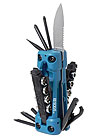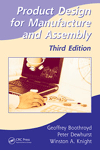
RE:Solve multi-tools contain more attachments than a
standard pocket knife, but are small enough to fit in one’s pants pocket. Photo
courtesy Wagic Inc.
RE:Solve multi-tools contain more attachments than a standard pocket knife, but are small enough to fit in one’s pants pocket. The RE:Solve line consists of four models: a 17-piece general purpose unit, an 11-piece unit for painters, a 10-piece unit for home decorators and a 12-piece unit for outdoors enthusiasts. Each model has specific tools that best serve the end-user. The home decor tool, for example, features a level, a tape measure and a pencil with a sharpener-all the things someone would need to hang pictures.
The capabilities of each multi-tool are impressive. Equally impressive is the fact that it took Wagic just one week to go from product concept to final CAD model, and just a few months to create prototypes of the multi-tools. The key was Wagic engineers’ use of Creo Elements/Direct software, made by Parametric Technology Corp.
Creo Elements/Direct software supports 2D and 3D files and offers a direct modeling approach that adapts certain 2D techniques to 3D design. For example, designers can move and stretch 2D geometry or even design within a 2D cross section of a 3D model.
Creo has three components. Engineers use Creo Sketch to convey design ideas. Creo Schematics diagrams cabling and piping routes. And Creo Layout helps users flesh out early concept layout work in 2D, but in a way that lets them ultimately evolve the design in 3D.
Creo enabled Wagic engineers to easily create, manipulate and edit 3D geometry, while maintaining design intent between iterations. More importantly, the software improved teamwork and efficiency at Wagic.
“Getting an idea out of someone’s head and into a prototype can be a very challenging undertaking,” says Michael Sprauve, chief technical officer of Wagic. “We were able to achieve fast design cycles by enabling more users to access and use the 3D data. In addition, we streamlined the workflows through Creo’s ability to let us edit 3D design data before analysis and propose design changes directly on the model.”
Once the CAD drawing was finalized, Wagic used a 3D printer to make five or six iterations of the tools and test their weight and feel. Final prototypes were then printed for each RE:Solve multi-tool model.
Sprauve says purchasers for the big box stores were impressed by the prototypes and their many uses-so impressed, in fact, that the stores’ initial orders totaled 700,000 units.
Immediately, Wagic began the tooling cycle, followed by quality reviews, a pilot run and full-blown production. The entire process took about eight months, including shipping of the first order. For more information on CAD modeling software, call 781-370-5000 or visit http://creo.ptc.com.





